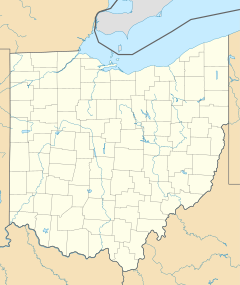Southern Ohio Correctional Facility
| Location | Valley Township / Jefferson Township, Scioto County, near Lucasville, Ohio |
|---|---|
| Coordinates | 38°52′28.26″N 82°58′12.19″W / 38.8745167°N 82.9700528°W |
| Status | Operational |
| Security class | Maximum security |
| Population | 1,179[1] (as of 12/14/2015) |
| Opened | 1972 |
| Managed by | Ohio Department of Rehabilitation and Correction |
| Warden | Ronald Erdos [2] |
The Southern Ohio Correctional Facility is a maximum security prison located just outside Lucasville, Ohio, United States. The prison was constructed in 1972. The current warden is Ronald Erdos.
1993 riot
On Easter Sunday, April 11, 1993, 450 Lucasville prisoners, including an unlikely alliance of the Aryan Brotherhood and Gangster Disciples, rioted and took over the facility for 11 days. The main causes, were serious overcrowding and mismanagement of the facility and Muslim frustration stemming from mandated tuberculosis testing.[3] In the Netflix documentary series Captive, inmate Siddique Abdullah Hasan claims that Muslim prisoners refused the test because it contained phenol, and therefore goes against Islamic restrictions concerning the consumption and handling of alcohol. Investigations conducted after the riot found that the gangs were also collaborating to murder inmates accused of being informants.[4] Nine inmates and one corrections officer were killed.[4]
During negotiations, the inmates did not feel they were being taken seriously, and there was discussion of killing a Corrections Officer in retaliation. Though the group never reached a decision on the killing, one of the prisoners decided it was time to take action. According to the prosecution, Officer Robert Vallandingham, who had been taken hostage, was handcuffed and strangled with a dumbbell from the prison weight room. However, testimony by Dr. Richard Fardal, Franklin County Deputy Coroner, disputed the claim that Officer Vallandingham was killed by a weight, saying that there was “no injury to the voice box or the trachea” and that “Mr. Vallandingham died solely and exclusively as a result of ligature strangulation.”[5] Testimonies vary as to which prisoner was responsible for his murder.[3] During those eleven days, representatives from the Sunni Muslims, Aryan Brotherhood, and Gangster Disciples met every day in an improvised leadership council.[6]
Four prisoners, Siddique Abdullah Hasan (Carlos Sanders), Jason Robb, George Skatzes, and Namir Abdul Mateen (James Were), were sentenced to death as a result. Keith LaMar (Bomani Shakur), unaffiliated with any of the above-mentioned groups, was sentenced to death for his alleged leadership of a group who killed inmates during the riot. He denies his leadership and claims the State of Ohio suppressed evidence that could demonstrate his innocence.[7] He was not present in L-6 during the majority of the riot, having been taken off the rec yard the first day by the State authorities and housed in the K block.
Following the riot, a class action was brought against the state officers, administrators and staff, by a legal team headed by civil rights attorney Al Gerhardstein, on behalf of the inmate victims of the riot. The state paid $4.1 million to settle the claims of the victims and agreed to a number of non-monetary terms as well, to remedy the overcrowding and mismanagement of the facility.[8]
Death row
The Southern Ohio Correctional Facility is where condemned Ohio prisoners are executed; however, prisoners awaiting execution are not housed there on a long term basis. Since the riots, the men's death row has been relocated three times. The first relocation was to the Mansfield Correctional Institution in Mansfield with the majority of inmates being moved later to the Ohio State Penitentiary, a supermax facility in Youngstown while a few remained at Mansfield. Currently, all but eleven[9] condemned inmates are housed in a new death row unit at the Chillicothe Correctional Institution in Chillicothe. Five high security inmates, most of whom were involved in the 1993 riots, remain at OSP with two others with serious medical conditions housed at the Franklin Medical Center in Columbus. Donna Roberts, the lone woman on Ohio's death row, as well as any future female prisoners sentenced to death, are and will be held at the Ohio Reformatory for Women in Marysville.[9]
Notable Inmates
- T.J. Lane - Perpetrator of the Chardon High School shooting.
See also
- Capital punishment in Ohio
- Captive, documentary series in which the 1993 riot was featured.
References
- ^ "Southern Ohio Correctional Facility". www.drc.state.oh.us. Retrieved July 30, 2016.
- ^ "Southern Ohio Correctional Facility".
- ^ a b Pfeifer, Paul. The Lucasville Prison Riot Archived March 4, 2016, at the Wayback Machine, Supreme Court of Ohio, 2005-05-18. Accessed 2009-06-30.
- ^ a b Beyerlein, Tom (April 3, 2013). "White supremacist gangs becoming increased threat in and outside of prisons". Springfield News-Sun. Retrieved April 4, 2013.
{{cite web}}: Unknown parameter|subscription=ignored (|url-access=suggested) (help) - ^ http://www.re-examininglucasville.org/2012/10/re-examining-lucasville-uprising-essay-1.html [dead link]
- ^ Lynd, Staughton, et al. Wobblies and Zapatistas, p.113.
- ^ "Letter from Bomani Shakur of the Lucasville 5". Kersplebedeb.
- ^ Kaufman (January 22, 1997). "Lucasville Inmates Settle for $4.1 Million". The Cincinnati Enquirer. Retrieved 6 June 2016.
- ^ a b "Ohio Death Row Inmates".
External links
- ODRC's Profile Page on SOCF
- Ohio Historical Society, 2005, "Lucasville Prison Riot", Ohio History Central: An Online Encyclopedia of Ohio History
- Hedges, Chris (Feb 22, 2015). We Kill Our Revolutionaries. (On the April 1993 uprising). Truthdig

